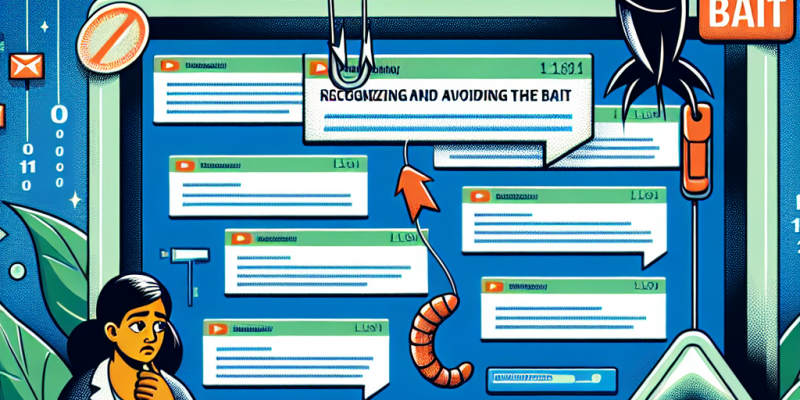Phishing Scams: Recognizing and Avoiding the Bait

Phishing Scams: Recognizing and Avoiding the Bait
In our increasingly digital world, phishing scams have evolved into one of the most pervasive threats to personal and organizational security. As cybercriminals develop more sophisticated techniques to deceive users, understanding how to recognize and avoid these scams is critical. This article explores the latest updates in phishing tactics and provides practical tips for safeguarding yourself against this ever-evolving menace.
What is Phishing?
Phishing is a form of cybercrime where attackers attempt to deceive individuals into providing sensitive information, such as passwords, credit card details, or personal identification. These scams often masquerade as legitimate entities, from banks to popular online services, creating a false sense of security that lures victims into a trap.
The Latest Trends in Phishing Attacks
-
Spear Phishing: Unlike traditional phishing attacks that target a broad audience, spear phishing focuses on specific individuals or organizations. Cybercriminals gather personal information from social media profiles or company websites to craft convincing messages. For instance, an email from a “trusted” colleague might request immediate action, such as updating invoice details or transferring funds.
-
Whaling: This is a form of spear phishing targeting high-level executives or important individuals within a company. Attackers employ tactics that exploit the unique authority and responsibilities of these targets, creating messages made to look highly legitimate to extract sensitive business information.
-
Clone Phishing: In this tactic, an attacker creates an identical replica of a previously delivered email that contains a link or attachment. The difference? The new email has a malicious link or attachment. This type of phishing capitalizes on the victim’s familiarity with the original message.
-
Voice Phishing (Vishing): Attackers use phone calls instead of emails to trick individuals into providing personal information. This tactic often involves spoofing legitimate phone numbers to make the scam appear more trustworthy.
-
SMS Phishing (Smishing): With the increase in mobile usage, SMS-based phishing has risen. Attackers send text messages with links that lead to fraudulent websites or prompt users to share sensitive data.
Recognizing Phishing Attempts
The hallmark of a phishing attack is its ability to blend in with legitimate communications. Here are some signs to look out for:
-
Unusual Sender Email Addresses: Check for subtle alterations in domain names. For example, an email that appears to come from “[email protected]” may actually originate from “[email protected]”.
-
Generic Greetings: Phishing emails often use generic salutations like “Dear Customer” rather than your name. Legitimate organizations usually address you personally.
-
Sense of Urgency: Scammers create a false sense of urgency, encouraging you to act quickly and without thorough examination. Messages like “Immediate action required” or “Your account will be suspended” are classic indicators.
-
Suspicious Links and Attachments: Hover over links to check their actual URLs before clicking. Be wary of unsolicited attachments, especially if they prompt you to enable macros or install software.
-
Spelling and Grammar Mistakes: Professional organizations usually proofread communications. Errors can be a red flag indicating a phishing attempt.
Avoiding the Bait: Best Practices
-
Verify Before You Click: Always verify the sender’s identity before clicking on links or downloading attachments. If in doubt, contact the organization directly using contact information from their official website.
-
Use Multi-Factor Authentication (MFA): Enable MFA on your accounts. This adds an extra layer of security, making it harder for attackers to gain access even if they have your password.
-
Educate Yourself and Others: Stay informed about the latest phishing techniques and educate your family, friends, and colleagues. Regular training sessions in organizations can significantly reduce the risks.
-
Install Anti-Phishing Tools: Use security software that includes anti-phishing features. Many web browsers also have built-in tools to help warn users about potentially harmful sites.
-
Report Phishing Attempts: If you receive a phishing email, report it to your email service provider and, if applicable, to the legitimate organization it impersonates. Reporting helps improve awareness and strengthens defenses.
-
Regularly Monitor Financial Statements: Keep an eye on your bank and credit card statements for unauthorized transactions. Early detection can help mitigate potential damage.
Conclusion
Phishing scams are a serious threat that can jeopardize personal finances, businesses, and sensitive information. By staying informed about the latest tactics and employing robust security practices, you can protect yourself and your organization from falling victim to these deceptive schemes. Always remember, when in doubt, it’s better to verify and be safe than to regret a hasty decision.














